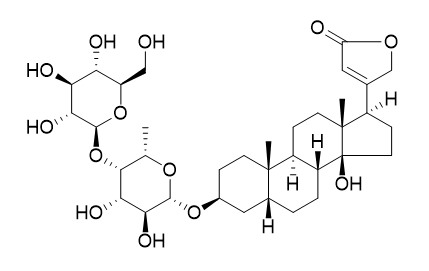Glucodigifucoside
Glucodigifucoside exhibits potent cytotoxicity against human renal adenocarcinoma cell line ACHN.
Inquire / Order:
manager@chemfaces.com
Technical Inquiries:
service@chemfaces.com
Tel:
+86-27-84237783
Fax:
+86-27-84254680
Address:
1 Building, No. 83, CheCheng Rd., Wuhan Economic and Technological Development Zone, Wuhan, Hubei 430056, PRC
Providing storage is as stated on the product vial and the vial is kept tightly sealed, the product can be stored for up to
24 months(2-8C).
Wherever possible, you should prepare and use solutions on the same day. However, if you need to make up stock solutions in advance, we recommend that you store the solution as aliquots in tightly sealed vials at -20C. Generally, these will be useable for up to two weeks. Before use, and prior to opening the vial we recommend that you allow your product to equilibrate to room temperature for at least 1 hour.
Need more advice on solubility, usage and handling? Please email to: service@chemfaces.com
The packaging of the product may have turned upside down during transportation, resulting in the natural compounds adhering to the neck or cap of the vial. take the vial out of its packaging and gently shake to let the compounds fall to the bottom of the vial. for liquid products, centrifuge at 200-500 RPM to gather the liquid at the bottom of the vial. try to avoid loss or contamination during handling.
Int J Mol Sci.2022, 23(21):13112.
J of App. Res. on Med&Aromatic Plants2020, 100291.
J Biosci.2020, 45:46.
Current Analytical Chemistry2024, 20(8):599-610.
Applied Biological Chem. 2020, 26(63).
J Agric Food Chem.2017, 65(13):2670-2676
Journal of Medical Sciences2024, 44(5):p 222-227.
Front Immunol.2023, 14:1240800.
Sci Rep.2024, 14(1):28864.
Mutlu Yanic S, Ates EG. JOTCSA.2023, 10(4);893-902.
Related and Featured Products
Biosci Biotechnol Biochem . 2015;79(2):177-84.
Cardenolide glycosides from the seeds of Digitalis purpurea exhibit carcinoma-specific cytotoxicity toward renal adenocarcinoma and hepatocellular carcinoma cells[Pubmed:
25345317]
Four cardenolide glycosides, Glucodigifucoside (2), 3'-O-acetylglucoevatromonoside (9), digitoxigenin 3-O-β-D-glucopyranosyl-(1 → 4)-β-D-glucopyranosyl-(1 → 4)-3-O-acetyl-β-D-digitoxopyranoside (11), and purpureaglycoside A (12), isolated from the seeds of Digitalis purpurea, exhibited potent cytotoxicity against human renal adenocarcinoma cell line ACHN. These compounds exhibited significantly lower IC50 values against ACHN than that against normal human renal proximal tubule-derived cell line HK-2. In particular, 2 exhibited the most potent and carcinoma-specific cytotoxicity, with a sixfold lower IC50 value against ACHN than that against HK-2. Measurement of cyclin-dependent kinase inhibitor levels revealed that upregulation of p21/Cip1 expression was involved in the carcinoma-specific cytotoxicity of 2. Further, compound 2 also exhibited the carcinoma-specific cytotoxicity toward hepatocellular carcinoma cell line.
J Chem Ecol . 1993 Jul;19(7):1355-69.
Cardenolides from Erysimum cheiranthoides: Feeding deterrents toPieris rapae larvae[Pubmed:
24249167]
Larvae of the cabbage butterfly,Pieris rapae, refuse to feed on the wild mustard,Erysimum cheiranthoides, due to the presence of alcoholextractable deterrents. The active components were extracted inton-BuOH, and this extract was separated into four fractions (I-IV) by reverse-phase HPLC. Fractions III and IV retained the feeding deterrent activity. The activity of fraction III was found to be due to the cardenolide diglycosides 1 and 2, which were previously reported as oviposition deterrents for gravidP. rapae butterflies. Three active compounds were isolated from fraction IV by column chromatography on silica gel followed by reverse-phase HPLC. These compounds were identified as a monoglycoside, digitoxigenin 3-O-β-D-glucoside (4), and two diglycosides, glucodigigulomethyloside (5) and Glucodigifucoside (6). An additional cardenolide isolated from fraction II was identified as cheirotoxin (7). All compounds were identified by UV, NMR ((1)H and(13)C), and mass spectrometry, as well as hydrolysis experiments. The feeding deterrent activity of these compounds was compared with that of related commercially available chemicals and other compounds isolated fromE. cheiranthoides.
Pharm Bull . 1957 Jun;5(3):272-6.
Studies on the constituents of Digitalis purpurea L. VI. Glucodigifucoside, a new cardiotonic glycoside[Pubmed:
13465290]



